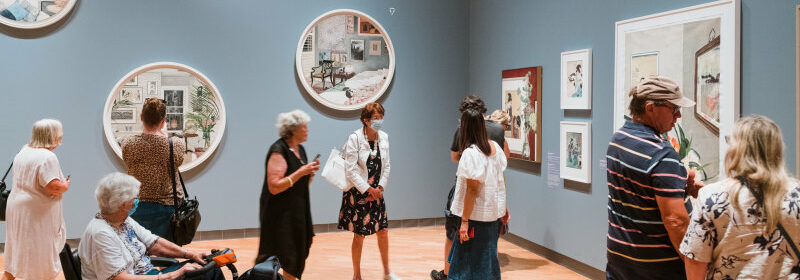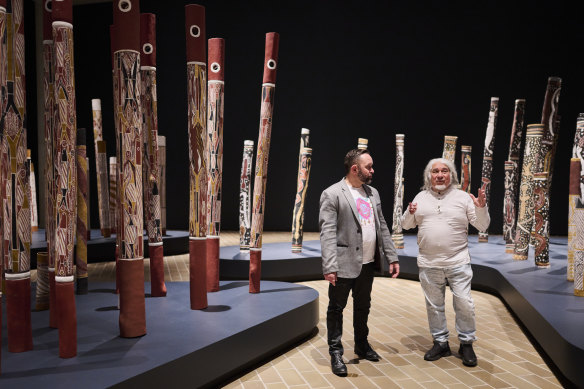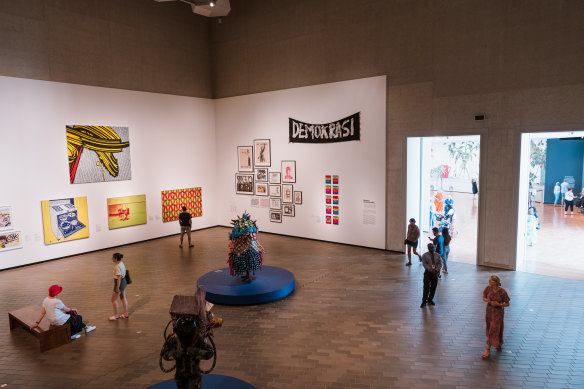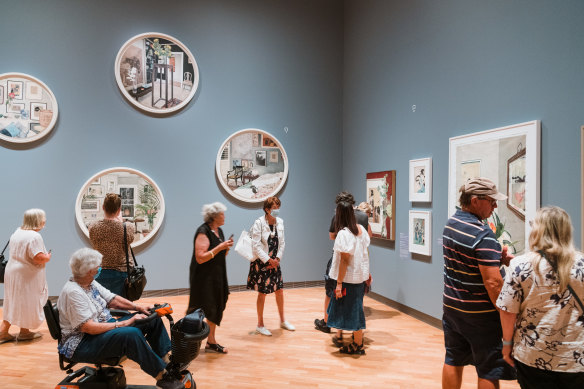Budget cuts force National Gallery to lean on donors for staff wages

The positions of 26 staff – or 12 percent of all those employed by the National Gallery of Australia – are being paid from the pockets of philanthropists because rising costs and budget cuts have left the custodian of Australia’s most valuable art collection unable to afford their salaries.
Ten staff members in the National Gallery’s curatorial department, 10 members of its digital learning team, two business support officers, and four of six positions in its Indigenous collections team are privately funded, according to figures drawn from the gallery’s corporate plan.
The Aboriginal Memorial at the NGA. Credit:Rohan Thomson.
Seven of those full-time roles, four in digital learning, have been funded by Queensland pastoralist and arts patron Tim Fairfax, the remainder supported anonymously or via bequests.
The gallery’s increasing reliance on donors for staff positions – the numbers are twice what they were three years ago – follows two major staff restructures in 2016 and 2020. In each restructure about 10 per cent of gallery staff were made redundant.
The situation has prompted renewed calls for the abolition of a public service-wide cost-cutting measure, known as the efficiency dividend, for all federal collecting institutions.
ACT senator David Pocock said he would look for a firm commitment from the Albanese government to reverse the funding cuts in the upcoming May budget.
“I’m calling on the government to commit to a funding boost for all of our national cultural institutions, and to remove the efficiency dividend which has eaten away at operational budgets for over a decade,” he said.
“This funding can’t just be about repairs and maintenance, we need core funding restored so that our galleries, museums, and archives have enough resources to innovate, curate and preserve the collection for generations to come.
“Our national cultural institutions should be a source of pride for all Australians. Collectively, our national cultural institutions, such as the National Gallery, hold billions in assets that are the property of all of us. It’s our collection, and it does little good if it can’t be properly preserved, curated or exhibited.”
The National Gallery faces a budget cliff from July when one-off Coalition government grants for essential works expire. Gallery chairman Ryan Stokes has warned the institution is facing job losses, the closure of the Canberra building two days a week, and the possible reintroduction of entry fees.
Most pressingly, the NGA says it needs $265 million over the next 10 years to waterproof and remediate its 40-year-old building with lifts and escalators, electric wiring, and air conditioners at the extreme end of their working life.
Albanese government sources who asked not to be named so they could discuss the May budget said it would contain new money for Australia’s national institutions.
What has not been decided is whether the money will be an increase in recurrent funding or be one-off payments to fix issues such as the NGA’s roof or to fund the National Library’s Trove collection.
Former general manager of the Australia Council and director of the Sydney Opera House Michael Lynch said the use of private funding for staff positions was highly unusual in Australia.
The National Gallery of Australia is increasingly relying on donors to pay staff salaries.Credit:James Brickwood
“The idea that many positions are funded by philanthropy rather than part of establishment funding of the gallery does signal just how tough it is to run institutions when governments have been putting the screws on them for a very long time,” he said.
“Would we fund positions at the Australia Council [of Arts] with philanthropic funds? That would never happen. I think it’s just an indicator of the NGA trying to fund positions in a difficult post-COVID world.”
Professor Peter Stanley, who worked as a historian at the Australian War Memorial and then the National Museum of Australia for 33 years, argues the “NGA is 50 years old and it won’t last forever”.
“Our national institutions are struggling to meet basic responsibilities because of 15 years of efficiency dividends introduced by Labor and gleefully embraced by the conservatives and the assumption that cultural institutions will get by on the dedication of their staff,” he says.
The National Gallery faces a budget cliff from July.Credit:James Brickwood
“If we truly valued our national history and culture everyone would get the funding the War Memorial gets. The fact that other institutions don’t is a sad reflection on the ineradicable imbalance in Australia’s understanding of itself.”
A gallery spokesperson said the positions supported by philanthropy were important focus areas for the gallery including education, online engagement and First Nations art. No conditions were attached by donors to the funded positions.
The First Nations team oversees the NGA’s world-leading Indigenous collection comprising 6000 individual works of art, and recently touring Ever Present: First Peoples Art of Australia to the National Gallery Singapore in 2022.
“For this portfolio to continue, private giving is essential into the future,” the gallery said.
Prime Minister Anthony Albanese has acknowledged the crisis facing national galleries and museums, conceding they had been “starved of funds” with extra funding for operations or to address the gallery’s decade-long maintenance backlog expected to be outlined in the May budget.
The National Library of Australia relies on donors to fund the single position of rare books and music curator, as well as for the digitisation of material for the Trove platform, the popular digital resource under threat of closure when funding also ends in June.
The Federal Arts Minister Tony Burke last month met leaders of eight national galleries and museums to assure them of government support.
“This is one of the many areas where essential government functions were only budgeted by the previous government to last until June 30 of this year,” a spokesperson for Mr Burke said.
“Decisions on future funding will be made as part of the May budget.”
A cultural guide to going out and loving your city. Sign up to our Culture Fix newsletter here.
Most Viewed in Culture
From our partners
Source: Read Full Article


